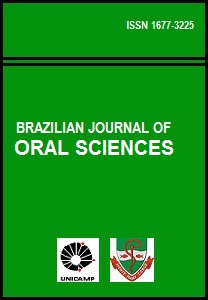Abstract
Aim: To compare marginal seal at tooth-material and material-material interfaces in the proximal box in combined amalgam/composite resin restorations. Methods: Mesio-occlusal-distal (MOD) cavities were prepared in 35 premolars and permanent molars with carbide bur. The distal proximal box was restored with amalgam (Permite, SDI) until reaching the height of pulpal floor. Dental tissues were etched with 37% acid and a bonding agent (Bond 1-SF, Pentron) was applied and cured. Composite resin (Filtek Z250, 3M-ESPE) was placed in layers in the mesial proximal box and occlusally, and light cured. Marginal adaptation was evaluated at the following interfaces: amalgam-tooth (A), amalgam-composite resin (AC) and composite resin-tooth (C). Microleakage was evaluated by means of methylene blue infiltration after 7-day water storage and thermocycling regimen (1500 cycles). Microleakage was assessed as percentage depth of horizontal dye penetration. Results: ANOVA showed statistically significant difference between A-AC and A-C (p<0.01). No statistically significant difference was found between AC-C interfaces (p>0.05). Mean microleakage values were A (73.529/28.71), AC (34.118/34.6) and C (40.435/ 34.965), according to Tukey’s test. Conclusions: Although the bonding mechanism between amalgam and composite has not yet been completely explained, amalgam/composite resin interface exhibited the lowest microleakage scores. Since amalgam/composite resin restorations exhibited lower microleakage scores than composite resin on the cervical surface, combined restorations can be considered as a biological and aesthetic alternative to conventional Class II composite or amalgam restorations.
This work is licensed under a Creative Commons Attribution 4.0 International License.
Copyright (c) 2015 Kosmas Tolidis, Christina Boutsiouki, Paris Gerasimou
Downloads
Download data is not yet available.

